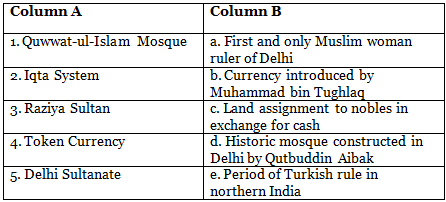The Delhi Sultanate Class 7 Worksheet History Chapter 3
Q1: Multiple Choice Questions (MCQs)
(i) Who is regarded as the founder of the Delhi Sultanate?
(a) Iltutmish
(b) Qutbuddin Aibak
(c) Raziya Sultan
(d) Alauddin Khalji
Ans: (b)
Qutbuddin Aibak is regarded as the founder of the Delhi Sultanate as he laid the foundation of the Slave dynasty.
(ii) What was the primary motivation behind Muhammad bin Tughlaq's introduction of token currency?
(a) To make coins more valuable
(b) To reduce the cost of minting coins
(c) To promote barter trade
(d) To enrich the nobility
Ans: (b)
Muhammad bin Tughlaq introduced token currency to reduce the cost of minting coins, but it led to economic chaos.
(iii) Which Sultan was the first to cross the Vindhya region and acquire control of the Deccan?
(a) Alauddin Khalji
(b) Iltutmish
(c) Ghiyasuddin Balban
(d) Raziya Sultan
Ans: (a)
Alauddin Khalji was the first Sultan to control the Deccan region.
(iv) What did the iqta system in the Sultanate administration involve?
(a) Land assignment to nobles in exchange for cash payments
(b) Promotion of trade and commerce
(c) Free distribution of land to peasants
(d) Tax collection from the common people
Ans: (a)
The iqta system assigned land to nobles in exchange for cash payments and tax collection.
Q2: Fill in the Blanks
(i) The establishment of Turkish rule in India was initiated by ________________.
Ans: Muhammad Ghori
(ii) Raziya Sultan, the only Muslim woman ruler of Delhi, defied gender norms and put on ________________ attire.
Ans: Male
(iii) The ruler who established the Khalji dynasty was ________________.
Ans: Jalaluddin Khalji
(iv) The Delhi Sultan who introduced token currency was ________________ bin Tughlaq.
Ans: Muhammad
(v) The last ruler of the Sayyid dynasty was ________________ Alam Shah.
Ans: Alauddin
Q3: Match the Column
Match the items in Column A with the correct descriptions in Column B. Ans:
Ans:
Q4: True or False
(i) Iltutmish is considered the real consolidator of Turkish conquests in North India.
Ans: True
Iltutmish is regarded as the real consolidator of Turkish conquests in North India.
(ii) Alauddin Khalji was the first Delhi sultan to acquire control of the Deccan region.
Ans: True
Alauddin Khalji was the first Sultan to control the Deccan region.
(iii) The caste system had no influence on society during the Delhi Sultanate period.
Ans: False
The caste system influenced society during the Delhi Sultanate period.
(iv) Timur's invasion had no significant impact on the Delhi Sultanate.
Ans: False
Timur's invasion weakened the Delhi Sultanate significantly.
(v) The iqta system involved distributing land to nobles in exchange for cash payments.
Ans: True
The iqta system assigned land to nobles in exchange for cash payments.
|
32 videos|186 docs|40 tests
|
FAQs on The Delhi Sultanate Class 7 Worksheet History Chapter 3
| 1. What was the Delhi Sultanate and when did it exist? |  |
| 2. Who were the rulers of the Delhi Sultanate? |  |
| 3. What were the major achievements of the Delhi Sultanate? |  |
| 4. How did the Delhi Sultanate impact Indian society and culture? |  |
| 5. What led to the decline of the Delhi Sultanate? |  |
|
32 videos|186 docs|40 tests
|

|
Explore Courses for Class 7 exam
|

|
















